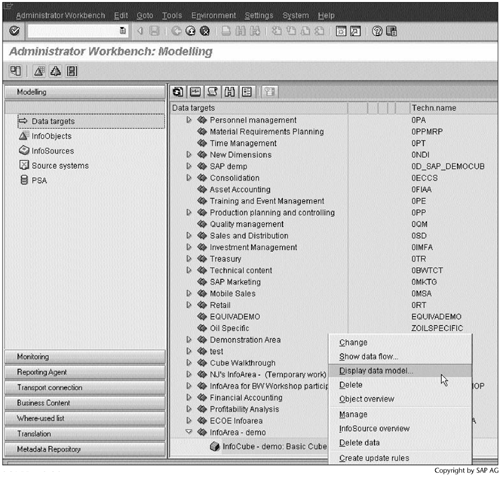Summary
In this chapter, we created an InfoCube. To display its data model, you can right-click InfoCube demo: Basic Cube, then select Display data model…(Screen 2.30).
SCREEN 2.30

The data model appears in the right panel of Screen 2.31.
SCREEN 2.31

Note
IO_SREG and IO_SOFF are not listed under IO_SREP as attributes; rather, they have been created as independent characteristics. Section 3.6, "Entering the Master Data, Text, and Hierarchy Manually," describes how to link IO_SOFF and IO_SREG to IO_SREP via a sales organization hierarchy. Section 7.2, "InfoCube Design Alternative I – Time-Dependent Navigational Attributes," discusses a new InfoCube design in which IO_SOFF and IO_SREG are IO_SREP's attributes.
Key Terms
| Term | Description |
|---|---|
| Key figure | Key figures are numeric values or quantities, such as Per Unit Sales Price, Quantity Sold, and Sales Revenue. The maximum number of characters allowed for the technical name is 9. |
| Characteristic | Characteristics are descriptions of key figures, such as Customer ID, Material Number, Sales Representative ID, Unit of Measure, and Transaction Date. The maximum number of characters allowed for the technical name is 9. |
| InfoObject | In BW, key figures and characteristics are collectively called InfoObjects. |
| InfoObject Catalog | InfoObject Catalogs are used to organize InfoObjects. Two types of InfoObject Catalogs exist: one for characteristics and one for key figures. The maximum number of characters allowed for the technical name is 30. |
| InfoArea | InfoAreas are used to organize InfoCubes and Info Objects. Each InfoCube is assigned to an InfoArea. Through an InfoObject Catalog, each InfoObject is assigned to an InfoArea as well. The maximum number of characters allowed for the technical name is 30. |
| InfoCube | An InfoCube consists of a fact table and its associated dimension tables in the star schema. The maximum number of characters allowed for the technical name is 30. |
Next…
We will load the data described in Chapter 1, Business Scenario and SAP BW, into the InfoCube.
Part I. Guided Tours
Business Scenario and SAP BW
- Business Scenario and SAP BW
- Sales Analysis A Business Scenario
- Basic Concept of Data Warehousing
- BW An SAP Data Warehousing Solution
- Summary
Creating an InfoCube
- Creating an InfoCube
- Creating an InfoArea
- Creating InfoObject Catalogs
- Creating InfoObjects Characteristics
- Creating InfoObjects Key Figures
- Creating an InfoCube
- Summary
Loading Data into the InfoCube
- Loading Data into the InfoCube
- Creating a Source System
- Creating an Application Component
- Creating an InfoSource for Characteristic Data
- Creating InfoPackages to Load Characteristic Data
- Checking Loaded Characteristic Data
- Entering the Master Data, Text, and Hierarchy Manually
- Creating an InfoSource for Transaction Data
- Creating Update Rules for the InfoCube
- Create an InfoPackage to Load Transaction Data
- Summary
Checking Data Quality
- Checking Data Quality
- Checking InfoCube Contents
- Using BW Monitor
- Using the Persistent Staging Area (PSA)
- Summary
Creating Queries and Workbooks
- Creating Queries and Workbooks
- Creating a Query Using BEx Analyzer
- Organizing Workbooks Using BEx Browser
- Using a Variable to Access a Hierarchy Node Directly
- Summary
Managing User Authorization
- Managing User Authorization
- Creating an Authorization Profile Using Profile Generator
- Creating an Authorization Object to Control User Access to the InfoCube Data
- Integrating Profile Generator and BEx Browser
- Summary
Part II. Advanced Topics
InfoCube Design
- InfoCube Design
- BW Star Schema
- InfoCube Design Alternative I Time-Dependent Navigational Attributes
- InfoCube Design Alternative II-Dimension Characteristics
- InfoCube Design Alternative III Time-Dependent Entire Hierarchies
- Other InfoCube Design Techniques
- Summary
Aggregates and Multi-Cubes
Operational Data Store (ODS)
- Operational Data Store (ODS)
- Creating an ODS Object
- Preparing to Load Data into the ODS Object, Then into an InfoCube
- Loading Data into the ODS Object
- Loading Data into the InfoCube
- Using 0RECORDMODE for Delta Load
- Summary
Business Content
- Business Content
- Creating an R/3 Source System
- Transferring R/3 Global Settings
- Replicating R/3 DataSources
- Installing Business Content Objects and Loading R/3 Data
- Summary
Generic R/3 Data Extraction
- Generic R/3 Data Extraction
- Creating Views in R/3
- Creating DataSources in R/3 and Replicating Them to BW
- Creating a Characteristic in BW
- Loading Data from R/3 into BW
- Summary
Data Maintenance
Performance Tuning
- Performance Tuning
- BW Statistics
- System Administration Assistant
- Tuning Query Performance
- Tuning Load Performance
- Summary
Object Transport
Appendix A. BW Implementation Methodology
Object Transport
Appendix B. SAP Basis Overview
Object Transport
- Object Transport
- Section B.1. SAP Basis 3-Tier Architecture
- Section B.2. Dispatcher, Work Processes, and Services
- Section B.3. Memory Management
Appendix C. Glossary
Appendix D. Bibliography
EAN: N/A
Pages: 106
